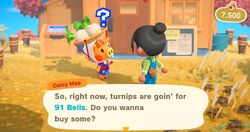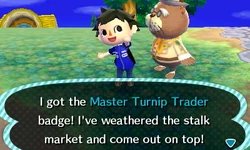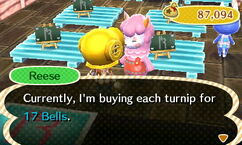| This page is currently under construction. Please help us expand this article by editing it. |

White turnips are a unique type of flora present in every Animal Crossing series game to date. They can be purchased every Sunday morning before 12 p.m. from Joan or Daisy Mae depending on the game. Unlike other items, the price of turnips fluctuates over time. The purchase price will be different every week. During the week, the player can sell turnips at different prices to make a profit. These prices will differ each morning and afternoon. This trade is nicknamed the Stalk Market.
Turnips must be sold within a week. Otherwise, they will rot by the following Sunday and lose their monetary value, regardless of stacks. Changing the game time or date will also cause spoiling, hence Joan's warning that the turnips "are highly sensitive to time paradoxes." In some games, some glitches prevent turnips from rotting.
If spoiled turnips are dropped on the ground outside, they will attract ants, cockroaches, (GCN) and flies (Wild World and beyond). Like other "garbage" type items, when sold to Reese, she will charge a disposal fee of 400 Bells.
Buying and selling in Animal Crossing, Wild World, City Folk, New Leaf[]
Buying[]
Turnips are purchased from the local trader Joan, a special character who wanders the town from 9 a.m. till noon on Sundays. She sells turnips in bundles of 10, at a weekly random price in the range of 90-110 Bells per Turnip. Unlike red turnips, white turnips can be bought in unlimited quantities.
Joan will not sell turnips if the player has recently changed the game time, explaining that she is out of stock for both white and red turnips. However, changing the console time directly rather than in-game can avoid this penalty.
Selling[]
White turnips are sold like any other item. In earlier games, Tom Nook is the middleman for selling turnips; in New Leaf, this role is taken by Reese. As with real-life stock trading, the exchange rate for turnips fluctuates. The price changes twice a day, first at the beginning of a new in-game day, and again at noon.
Selling prices for turnips vary from as low as 15 Bells a turnip to as high as 990, but prices frequently range between 50 and 200. High investments in turnips that are sold at extremely high prices can quickly turn into several millions of Bells of profit in a few weeks.
Though prices are random, there is a loose tendency for them to rise from Monday through Wednesday and then drop Thursday through Saturday. Turnips cannot be sold on Sunday because turnip prices cannot establish on a Sunday.

In New Leaf, a player is given a gold badge for making a profit of 10,000,000 Bells with turnips.
In New Leaf, the Stalk Market can be somewhat predicted, adhering to one of the four following patterns:
- Random - This pattern features a sequence of 3 consecutive falling prices below 80, followed by a small spike to 101-135+ Bells; the 2nd and 3rd price may drop by 4-12+ Bells. Otherwise, it consists of mostly random prices ranging from 40-200 which usually makes it easy to spot but difficult to pinpoint the best selling price. It's best to sell on any 120+ price or the sequence's spike, whichever occurs first.
- Decreasing - In this pattern, values decrease by 3-5 bells twice a day. There are no increases whatsoever and therefore it is impossible to make a profit. The other two patterns (that aren't random) are similar to this one and so it can be hard to identify if you have this pattern or not. If the prices haven't increased on Thursday afternoon, then it is guaranteed you have this pattern.
- Large Spike - This pattern is similar to the decreasing pattern but features a sequence of 5 consecutive numbers somewhere between Monday morning and Saturday afternoon. There will be 3 large increases followed by 2 large decreases, with the 3rd value being the highest. To make a profit, sell on the 3rd increase. If you just miss it, sell immediately as you will still make a profit, albeit a smaller one.
- Small Spike - This pattern is also similar to the decreasing pattern, with its own sequence of 5 consecutive numbers. In about half of the cases, this will be 4 increases followed by 1 small decrease; otherwise, the 2nd price will actually be 1-25+ Bells lower than the first, followed by a larger increase. Either way, the 4th value will the highest. Compared to the Large Spike pattern, values increase by a smaller amount each time ranging from 1-40+ Bells. To make a profit, sell on the 4th price of the sequence. Again, if you just miss it, then sell as soon as possible.
Buying and selling in New Horizons[]
Buying[]
Turnips in New Horizons are purchased from Daisy Mae, the granddaughter of Joan from previous entries. She wanders the player's island on Sundays from 5 a.m to 12 p.m. to sell the player white turnips. She may still be present on the island after 12 p.m. but she will not sell the player anything. Like her grandmother, Daisy Mae will sell turnips at a random price between 90 and 110 bells.
Selling[]
Timmy and Tommy in Nook's Cranny will buy turnips every day, except for Sundays, at a different price every morning (before 12 p.m.) and every afternoon (12pm-10pm). Their price may be as low as 9 Bells, and as high as 660 Bells.
Time travel has no effect on changing the price that week. However, time traveling backwards in time will rot any turnips the player has purchased.
In New Horizons, the Stalk Market follows the 4 following patterns: Random, Large Spike, Decreasing, and Small Spike. The pattern from the previous week will impact the likelihood of the following week's pattern.
In the table below, the first column is the previous week's pattern. The row for that pattern shows the probability of getting each pattern the week after. (For example, if there was a Large Spike pattern last week, this week there will be a 50% chance of getting the Random pattern, a 5% chance of getting the Large Spike, a 20% chance of getting the Decreasing pattern, and a 25% chance of getting the Small Spike.)
| Random | Decreasing | Large Spike | Small Spike | |
|---|---|---|---|---|
| Random | 20% | 15% | 30% | 35% |
| Decreasing | 25% | 5% | 45% | 25% |
| Large Spike | 50% | 20% | 5% | 25% |
| Small Spike | 45% | 15% | 25% | 15% |
From this we can calculate the eventual percentage of occurrences for each pattern (rounded, accurate to within 1%). If you do not know anything about previous patterns, these are the probabilities for each pattern occurring on a given week.
| Random | Decreasing | Large Spike | Small Spike |
|---|---|---|---|
| 35% | 15% | 25% | 25% |
The 4 patterns are as follows:
- 1. Random - This includes increasing phases and decreasing phases throughout the week.
- In a Random Pattern, your maximum profit will only ever be 140% of whatever your base price was. Your best bet here (if you don’t have any friends whose island you can visit) is to sell the moment it is higher than your buying price. Unless of course, RNG is not in your favor, and during the Increasing Phase, you always get 90% of your base price. But that likelihood is low. You are much more likely to either break even or make a semi-decent profit.
- This pattern follows 6 phases in order:
- Increasing Phase 1: Lasts a random amount of half days, ranging between 0 and 6 half days.
- Decreasing Phase 1: 50% chance of lasting 2 half days and 50% of lasting 3 half days.
- Increasing Phase 2: Typically a very small increase. The exact duration is found by taking 7 half days and subtracting Increasing Phase 1's length and Increasing Phase 3's Length.
- Decreasing Phase 2: 5 half days - Decreasing Phase 1 Length.
- Increasing Phase 3: A random amount between 0 and Increase Phase 2 Length - 1.
- 2. Decreasing - A full week of losing bells.
- This is the worst pattern of the four and if you find you are caught in this your best bet is to either sell immediately or find a friend and sell on their island. Every day you wait, you will lose more and more profit. Monday morning's price will be 85%-90% of your Base Rate, and it will decrease 3%-5% each day. If you are lucky, the turnip price may be lower than 100 and you can separate your turnips so that they will not rot in stacks, and you will get a small profit.
- 3. Large Spike The most profitable pattern.
- At first, this may look like a decreasing pattern. But keep an eye out! Remember that a decreasing pattern will keep decreasing every day. If at any point your decreasing pattern increases you may be looking at a large spike pattern. More importantly, if the 3rd half day after your first increase is greater than or equal to 2X your base price then you are definitely in a large spike. Keep a careful eye out for massive increases and remember that your third one is going to be the best!
- This Pattern follows 4 phases in order:
- Steady Decreasing Phase: between 1 and 7 half days. The first half-day is 85%-90% of Base Price. Every half-day after is an additional decrease of 3%-5%.
- Sharp Increasing Phase: always 3 half days. Half-day 1 is 90%-140% of Base Rate. Half-day 2 is 140%-200% of Base Rate. Half-Day 3 is 200%-600% of Base Rate.
- Sharp Decreasing Phase: always 2 half days. Half-day 1 is 140%-200% of Base Rate. Half-day 2 is 90%-140% of Base Rate.
- Random Decreasing Phase (may not occur): the remainder of the week every day to be 40%-90% of Base Rate.
4. Small Spike- This isn’t as exciting as the Large Spike pattern but you will be happy to be in this one as they share similarities. When the second phase of this pattern kicks in players can expect profit.
- This pattern contains three main phases:
- Decreasing Phase 1 (may not occur): 0-7 half-days in length. The Base rate is set to be 40%-90% of the original Base Rate, then decreasing 3%-5% every half-day of this phase.
- Increasing Phase: always 5 half-days. Half-Day 1 & 2's Base Rate is set to be between 90% and 140%. For half-day 3-5, the Base Rate is set to be between 140% and 200%. All 3 of these days have the same potential earnings of anywhere between 1.4x and 2x your base price.
- Decreasing Phase 2 (may not occur): the remainder of the week. Same as decreasing phase 1.
This information was compiled by /u/Edricus with datamining by Ninji on April 1st, 2020. The doc on the original findings is here: https://docs.google.com/document/d/1bSVNpOnH_dKxkAGr718-iqh8s8Z0qQ54L-0mD-lbrXo/edit
Calculator[]
This is a calculator for figuring out the profits from selling turnips. Currently, this is only fully accurate for New Leaf. If playing on New Horizons, just remember that the price of turnips caps at 660, and pretend that Joan and Reese are instead Daisy Mae and the Nooks, respectively.
Note: To load it, use the desktop version of the website. This is because it is written using JavaScript on MediaWiki:Common.js.
Glitches and exploits[]

Reese offering an incredibly low price of turnips to a player.
Time-traveling consequence[]
When the player changes the time in Animal Crossing, Joan will arrive in town out of stock for both turnip types, a consequence of attempting to exploit time travel. A workaround for this is changing the Wii/DS time forward a minute, re-synchronizing the game time with the console time. However, to buy Joan's turnips will require waiting a week until she visits again.
Another way to avoid this is by changing the console time. Changing the console's time changes the game's time, but not the other way around so there are no consequences.
Table glitch[]
In Wild World, placing turnips on a table inside the player's house can prevent them from rotting. To do this, first, the player must drop a tool in front of the table, then drop the turnip which should land on the table. If the table trick is attempted, the turnips will not spoil overnight.
Visiting other towns glitch[]
In Animal Crossing, if the player has turnips in their inventory and they travel on the train to a village with clock settings earlier in time than the most recent Sunday in the traveling character's town, they will turn spoiled when arriving at the destination.
In New Leaf, this no longer occurs. This potentially allows for infinite profit, as two people (or one person with two systems) can, in theory, have one game with Joan currently in town and another with a high turnip price at Re-Tail (ideally 500+), and travel between the two with no consequence.
Trivia[]
- The choice of turnips as the tradeable item is because the Japanese words for turnip, 蕪 (kabu), and stock, 株 (kabu), are both pronounced the same way.
- In New Horizons eating turnips has a practical use, as eating a bundle of 10 will instantly fill the stamina bar, which is much faster than eating 10 fruits. Also, turnips are a recipe for some food dishes.
- In New Leaf, turnips can automatically stack if multiple turnips are bought all in one transaction, unlike fruit which can only be manually stacked.






